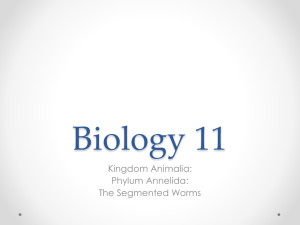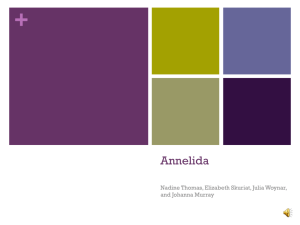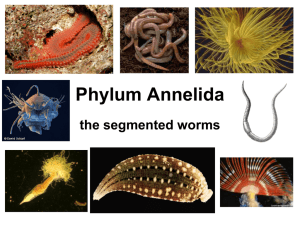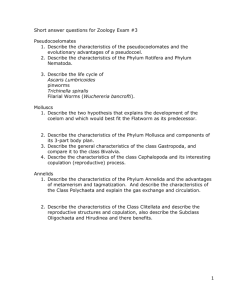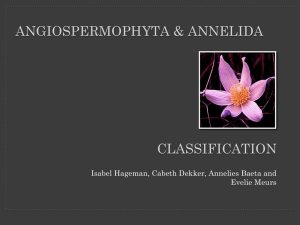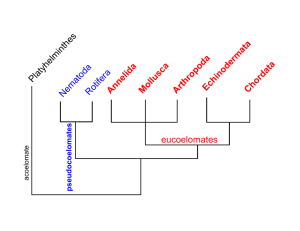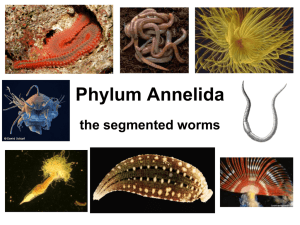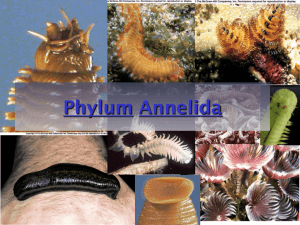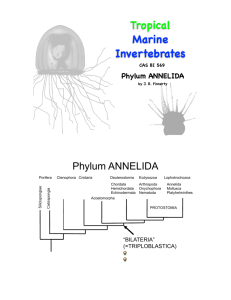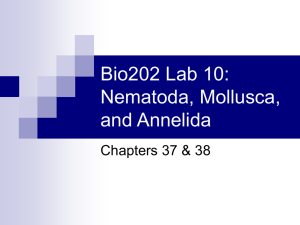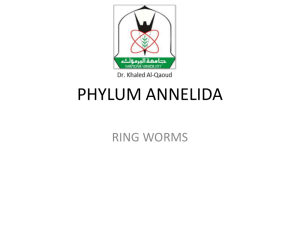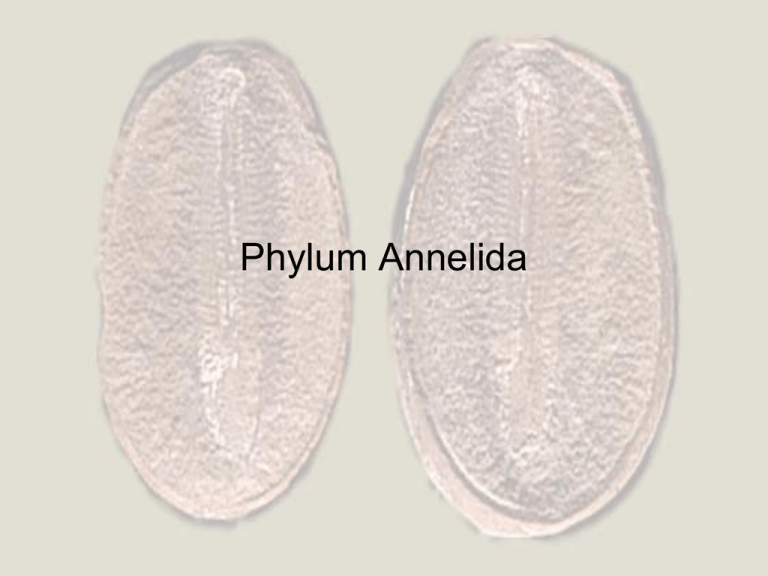
Phylum Annelida
Phylum Annelida
Terrestrial, marine,
freshwater.
Repeating segments.
Triploblastic.
True coelomates – complete
gut.
Closed circulatory system.
Well developed nervous
system.
Respiratory organs.
Protostome development.
Metamerism (unspecialized)
segmentation.
One or more pairs of setae.
Phylum Annelida
• Ancestral Traits
– Coelomate
– Lophotrochozoan- non-molting
protostomes
– Protostome
– Closed circulatory system
– Cephalization
Spirobranchus giganteus
Christmas tree worm
• Derived Traits
– Segmentation
• Metamerism
• Septa
– Setae
• Bristles
– Myelinated neurons
~ 40K species of annelids
Systems
• Integument- epidermis is one cell layer with mucous gland
that secrete a moist cuticle.
• Skeletal -hydrostatic (using coelom)
• Muscle- longitudinal and circular muscles Each segments
muscles are independent of the other segments.
• Digestive- complete, complex, with absorption and
digestive glands and excretory cells.
Systems (continue)
• Excretory- a pair of nephridia per segment.
• Respiratory -through skin, some through parapodia; tubeworms
have gills.
• Circulatory- closed system, use hemoglobin as oxygen carrier.
• Nervous- dorsal brain; ventral, double, solid nerve cord, with
ganglia in each segment.
• Endocrine- hormones secreted by nervous system.
• Reproductive– Dioecious in Polychaeta; no special organs, posterior end becomes gonads.
– Monoecious in Oligochaeta and Hirudinea; Clitellium.
Annelid Taxonomy
• Phylum Annelida (an-nel-i-da)
– Class Polychaeta (poly-key-ta)
• Nereis, Aphrodita, Chaetopterus, Arenicola, Amphitrite
– Class Clitellata
– Subclass Oligochaeta (ol-e-go-key-ta)
• Lumbricus, Tubifex
– Subclass Hirudinea (hi-ru-din-e-a)
• Hirudo, leech
• Earthworm dissection
Annelid Taxomony
• Class Polychaeta (many bristles)
– most numerous # species
– marine
Hermodice
crunculata
Annelid Taxomony
• Class Polychaeta
• Class Clitellata
– Subclass Oligochaeta (few bristles)
• Freshwater, marine & terrestrial
Lumbricus terrestris
Annelid Taxomony
• Class Polychaeta
• Class Clitellata
– Subclass Oligochaeta
– Subclass Hirudinea
• Fixed # segments (34)
• Setae absent
Hirudo
medicinalis
Annelid Phylogeny
Annelid Body Plan
Setae
Class Polychaeta
• Highly specialized head
regions
– Antennae
– Sensory palps
– Feeding appendages
• Paired extensions of body
Bispira bunnea
(parapodia)
sabellid worm
• Often tube-dwelling
– Burrow into substrate and secrete mucus/
CO3 materials
Spirobrancheus giganteus
Polychaete Anatomy
http://www.telegraph.co.uk/news/picturegalleries/picturesoftheday/9093
134/Pictures-of-the-day-20-February-2012.html
Parapodia with setae
Polychaete Anatomy (cross section)
Polychaeta
Amphitrite
Polychaeta
Lugworm (Arenicola sp)
Polychaeta
Polychaeta
Parchement worm
Clade-Siboglinidae
Riftia pachyptila
Ridgea sp
Giant tube worms (Vestimentifera)
trophosome
Riftia pachyptila
http://www.bbc.co.uk/nature/life/Polychaete/by/rank/all
Polychaete Reproduction
• Most are dioecious-few monoecious
• Some asexually but sexually more common
• Trochophore larvae
• Some species develop specialized
segments containing gametes
– Epitokes
– Segments are released and
gametes burst out
Polychaete Asexual Reproduction
• Epitokes are essentially
buds
• Clues to ancestral origin of
segmentation
– Segmentation may have
been derived from
incomplete budding
processes
Typosyllis nipponica
Samoan palolo worm
Palola viridis
Class Oligochaeta
Class Oligochaeta
• Defining characteristics
– Pronounced cylindrical
glandular region of the body
= clitellum
• Second largest class in the
phylum Annelida
• Most spp. are earthworms,
very few are marine
27
Phylum Annelida
Polychaetes and Oligochaetes
• Oligochaetes differ from
polychaetes in several
ways:
– No parapods, fewer setae (if
at all)
– Hermaphroditic with sex
cells produced in a separate
section
– No larval stages
Giant Gippsland earthworm
28
Phylum Annelida
Oligochaete Anatomy
Oligochaete Anatomy
Setae: a.k.a. Bristles
Oligochaete Reproduction
Oligochaete Development
• For terrestrial oligochaetes, development is direct without any
larval forms
• Some aquatic oligochaetes retain a trochophore-like larval stage
Site for earthworm anatomy:
http://www.naturewatch.ca/english/wormwatch/resources/anatomy.html
Quick and Easy Earthworm Morphology Guide
-Earthworms can be classified by size,
burrowing habits, and color
-Number, location and pattern of
genital tumescences (GT) and
tubercular pubertatis (TP)
-Location & shape of clitellum
Aporrectodea turgida
Lumbricus rubellus
Common Terrestrial Oligochaetes: Earthworms
Octagonal Tail Worm
Dendrobaena octaedra
Eisenia foetida
Redworm
http://www.earthlife.net/inverts/oligochaeta.html
This link shows diversity of Oligochaetes!
Earthworm
Dissection
Return to taxonomy
Cross section
Aquatic Oligocheates
Subclass Hirudinea
• Defining characteristics
– Posterior sucker
• Predominately freshwater,
but do occur in all seas and
moist soil
• Leeches do not burrow,
lack parapods and setae
• Clitellum only visible
during breeding
38
Phylum Annelida
Horse leech-actually feeds
on small worms
Haemopis sanguisuga
Great Amazon Leech
Haementaria ghiliani
Subclass Hirudinea
Leech Anatomy
• Anterior sucker is small
and contains the mouth
– Anterior sucker
creates a wound with
saw like jaws
• Leeches drink other
animals’ blood, usually
vertebrates
– Can be carnivores,
or scavengers;
leeches are not set in
their feeding habits
41
Phylum Annelida
Hirudo medicinalis
More leech info:
http://www.earthlife.net/inverts/hirundinae.html
Leech Reproduction
• Leeches are
simultaneous
hermaphrodites that lack
a free-living larvae stage
• Fertilization is internal
through copulation
• Development occurs in a
cocoon similar to the
Oligochaetes
44
Phylum Annelida

